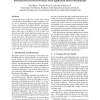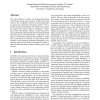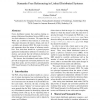IPTPS
2003
Springer
14 years 4 months ago
2003
Springer
We are building Coral, a peer-to-peer content distribution system. Coral creates self-organizing clusters of nodes that fetch information from each other to avoid communicating wi...
IPTPS
2003
Springer
14 years 4 months ago
2003
Springer
IPTPS
2003
Springer
14 years 4 months ago
2003
Springer
- An unwritten principle of the Internet Protocol is that the IP address of a node also serves as its identifier. We observe that many scalability problems result from this princi...
IPTPS
2003
Springer
14 years 4 months ago
2003
Springer
In this paper, we describe an ongoing effort to define common APIs ctured peer-to-peer overlays and the key abstractions that can be built on them. In doing so, we hope to facilit...
IPTPS
2003
Springer
14 years 4 months ago
2003
Springer
Much of the existing work in peer to peer networking assumes that users will follow prescribed protocols without deviation. This assumption ignores the user’s ability to modify ...
IPTPS
2003
Springer
14 years 4 months ago
2003
Springer
In tree-based multicast systems, a relatively small number of interior nodes carry the load of forwarding multicast messages. This works well when the interior nodes are dedicated...
IPTPS
2003
Springer
14 years 4 months ago
2003
Springer
Considerable research effort has recently been devoted to the design of structured peer-to-peer overlays, a term we use to encompass Content-Addressable Networks (CANs), Distribut...
IPTPS
2003
Springer
14 years 4 months ago
2003
Springer
This paper addresses a simple, yet fundamental question in the design of peer-to-peer systems: What does it mean when we say “availability” and how does this understanding imp...
IPTPS
2003
Springer
14 years 4 months ago
2003
Springer
In a peer-to-peer file-sharing system, a client desiring a particular file must choose a source from which to download. The problem of selecting a good data source is difficult...
IPTPS
2003
Springer
14 years 4 months ago
2003
Springer
Every distributed system that employs linking requires a Reference Resolution Service (RRS) to convert link references to locations. We argue that the Web’s use of DNS for this ...



